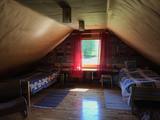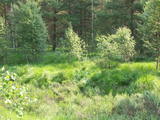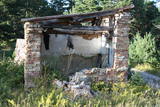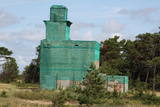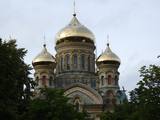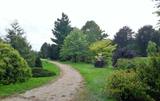| Нo | Название | Описание |
|---|---|---|
|
Bed & breakfast "Upes", in the centre of Livonian village Pitrags. Natural toilet. Local products. Lunch boxes, transfer service on request. |
||
|
Аттрактивный ремесленник является одним из гончаров «Школы гончаров» («Пудниеку скулас»), использующей накопленные предками знания. В мастерской Malny Wylky можно наблюдать традиционный процесс рождения работ от формирования на ножном гончарном круге до обжигания в дровяной печи в технике окуривания. Осмотр и приобретение работ. Весма пишет маслом и покажет свои работы. |
||
|
The word grīnis in Latvian refers to a very unusual type of forest – pine trees growing on sandy soil. There are two types of this environment – the heather type and the grass type. This is the result of long-lasting interaction between nature and humankind, and such sites are found in just a few places along the shores of the Baltic Sea in Latvia. A very rare plant which grows in the area – cross-leaved heath – was the main reason why a nature reserve was established here in 1936. An abandoned former rail line between Ventspils and Liepāja crosses the reserve from the North to the South. Visits to the reserve are strictly prohibited. |
||
|
В советское время и у поселка Ужава находился пост береговой погранохраны. О теперешнем использовании объекта еще недостаточно информации.
|
||
|
Кафе «Кукабурра». Находится на 115 км Видземского шоссе (A2). Предлагают принять участие в процессе выпечки ржаного хлеба, который проходит в конце каждой недели. Латышский интерьер, продукты от надомников и крестьян. Можно посетить музей хлеба. Латышская кухня: Салат из куриной печени, суп из баранины, суп с фрикадельками, холодный суп, жареный сом, тушенная свинина, картофельные блины, блины с варением, сырники, слойка из черного хлеба. Особое блюдо: Испеченный самими ржаной хлеб. |
||
|
Die nach dem Bau der Straße Tallinn – Narva gefundene und rekonstruierte 36 alte Bestattungen (8. – 7. Jh. vor Christus) ist ein interessantes archiologisches Denkmal mit einem Besucherzentrum und einer geschichtlichen Ausstellung. |
||
|
Закрытая и охраняемая территория на берегу озера Бушниеку в Сталдзене. Бывшее здание прожекторов находится на крутом берегу Сталдзене.
|
||
|
Собор построен в византийском стиле в 1900 - 1903 гг. как военный гарнизонный приход, (в честь защитника всех моряков Святого Николая), в освящении которого участвовал император Николай II. Роскошное здание было разграблено немцами во время Первой мировой войны. Во время Первой независимой Латвийской Республики кафедральный собор действовал как храм Лиепайского гарнизона. Советская армия использовала помещения собора в качестве кинотеатра, склада, спортивного клуба для матросов. Сохранились истории о том, что советские солдаты отламывали от икон кусочки золотой мозаики. Теперь в церкви - православный приход. В строительстве кафедрального собора использована уникальная беспрерывная технология бетонирования, поэтому конструкции постройки не имеют опорных колонн, и тяжесть конструкций приходится только на стены здания. Стены удерживаются четырьмя перекрестными сводами арок. В настоящее время это самый высокий православный кафедральный собор в Латвии. |
||
|
Установлен напротив Крустпилсского замка, на улице Ригас. Памятник, построенный в 1925 году и восстановленный в 1992 году (автор A. Бирзниекс), установлен в честь павших крустспилсчан в боях за свободу Латвии. Отсюда приоткрывается вид на Маленькую Даугаву, Даугавсалиню и островок Адамсона (Крустспилс). |
||
|
Находится ~ в 1 км на восток от центра Априки. Дворец господской усадьбы (стиль барокко) строился с 1742 по 1745 гг., а башня неоготического стиля как пристройка возводилась в конце XIX века. На фронтоне главного фасада дворца выполнен рельеф из песчаника с гербом родов баронов Остен – Сакенов и Корфов, который является самым роскошным элементом среди подобного рода имений Латвии. В здании сохранились и первоначальные элементы интерьера (осматриваются в сопровождении гида) – дверные створки, расписанная голландская печь, оконные дубовые ставни, коробки, чеканные металлические детали и паркет. В комплекс господской усадьбы входит дом управляющего, дом прислуги, хозяйственные постройки и парк. С 1920 года во дворце господской усадьбы действует школа и устроен музей края, который непременно следует посетить! Сейчас в музее выставлена коллекция этикеток производимого в Латвии хлеба. В 1901 году господскую усадьбу приобрел Карл Густав Маннергейм (1867 - 1951), который был президентом государства Финляндии и легендарным автором системы фортификации линий Маннергейма - Зимняя война (1939 - 1940). |
||
|
Находится на обочине шоссе Рига – Вентспилс (A10). Летом работает открытая терраса. Латышская кухня: Салат из говяжьего языка, холодный суп, бульон с фрикадельками, «крестьяньчик», свиные ребрышки, картофельные и тонкие блинчики, мусс. Особое блюдо: Харчо от кафе «У Яниса». |
||
|
This section of the seacoast of Vidzeme is of outstanding scenic beauty with a lot of rocky capes and boulders in the sea alternating with small, sandy coves where the small streams and rivulets, which dry out in summer, flow into. Occasionally, the beach is completely covered with the gray backs of stones. In Zvejniekciems you need to make a detour around the estuary of the Aģe River and the Skulte port. In some places, small patches of reeds appear, while near Tūja you will see the first sandstone outcrops. Some part of the route can be covered via the beach or via a trail meandering through the dune forest with old pines. At the end of the route, you can see the unique lamprey fishing method - Svētupes nēģu tacis. |
||
|
Atrodas pilsētas centrā - Tirgus laukuma malā. Dievnams tapis 1495. g., pēc Livonijas ordeņa mestra Valtera fon Pletenberga (~ 1450. – 1535.) pavēles. Gadsimtiem ritot, ēka pārbūvēta un tagad redzamais tornis celts 1907. g. Baznīcā apskatāmi nozīmīgi kultūrvēstures pieminekļi: altārglezna “Golgāta” - H. Kīperta darināta kopija (pēc K. Arnoldi Kandavas luterāņu baznīcas oriģināla (1864. g.)), muižniekam Fīlipam Drahenfelsam veltīta epitāfija (B. Bodekers, 16. un 17. gs. mija), A. D. Tīzenhauzenas kapu plāksne (1648. g.), kristāmtrauka pamatne (18. gs.) un piemiņas plāksne 1. pasaules karā un Latvijas Brīvības cīņās kritušajiem draudzes locekļiem (1925. g.). Ap Tirgus laukumu (atjaunots, jauka strūklaka) izvietojies Dobeles vēsturiskais centrs. |
||
|
Found at Rīgas Street 22A, this impressive building was suggested by Latvian President Kārlis Ulmanis and built in 1936 and 1937 after a design by the architect Verners Vitands. It is seen as one of the most outstanding architectural monuments from the first period of Latvian independence, and it is said that it was once the most modern multifunctional building in all of Europe. The building now houses the Daugavpils Theatre, the Latgale Central Library, the Latvian Cultural Centre, the Latvian House, the US Information Centre, the Daugavpils Tourism Information Centre and other institutions. Unity Square is alongside the building, and beautiful compositions of flowers are nearby during the growing season. |
||
|
Обширнейшая в Балтии экспозиция, знакомящая с материальной культурой земгалов в эпоху железного века. Богатое собрание земгальских украшений, оружия и предметов быта, крупнейшая в Балтии коллекция мечей. Экспозиция размещена в помещениях отреставрированного защитного строения Терветского деревянного замка XII века. Ежегодно в выходные второй недели августа здесь проводится Международный праздник земгалов - крупнейший фестиваль Балтии, посвященный этапу раннего средневековья. |
||
|
В хозяйстве по старинным бабушкиным рецептам, на листьях клена пекут душистый «Кисло-сладкий кузнечный» и Кузнечный ржаной» хлеб, хрустящую корочку которого смазывают льняным маслом. Предлагается поучаствовать в процессе выпечки хлеба, дегустация и приобретение. |
||
|
Дубравский дендрарий был заложен в 1958 г. на базе Дубравской лесной научно-исследовательской станции, неподалеку от деревни Вайшвидава, что под Каунасом. Сотрудники дендрария собирают, хранят и экспонируют ценные с научной, познавательной и декоративной точки зрения растения местной и привозной дендрофлоры. Дендрарий занимает около 50 га. В нем растет более 800 видов, подвидов, вариететов (дикорастущих разновидностей) и культиваров (вариантов неизвестных в природе и искусственно выращенных растений) арборифлоры. Некоторые разделы дендрария (коллекция хвойных и вересковых растений, интродукционно-карантинный питомник и экспозиция редких деревьев и кустарников) доступны для посещения только по предварительной договоренности. |
||
|
В фондах музея хранится более 120 000 предметов, экспозиция представляет историю Лиепаи и юга Курземе – начиная с каменного века и вплоть до 19-го века. Посетителям предлагается также экспозиция, посвященная жизни и творчеству скульптора по дереву Микеля Панкока (1894-1983). В других выставочных залах периодически проводятся выставки современного искусства. |
||
|
Ein ehemaliges Fischerdorf am Ufer des Kurischen Haffs. Hierher sind die Bewohner der Dörfern umgezogen, deren Dörfe unter dem Sand der Wanderdünen begraben wurden. Holzbebauung des 19 – 20 Jh. |
||
|
A unique farmyard that includes a full set of buildings typical of this area. The farmstead buildings reflect at least 300-400 years of Latvian nation-building development. In the area it is possible to stay in a dwelling house (2 rooms, two people each) and in the tents. Picnic places available. It is also possible to organize different events and activities. |
||
